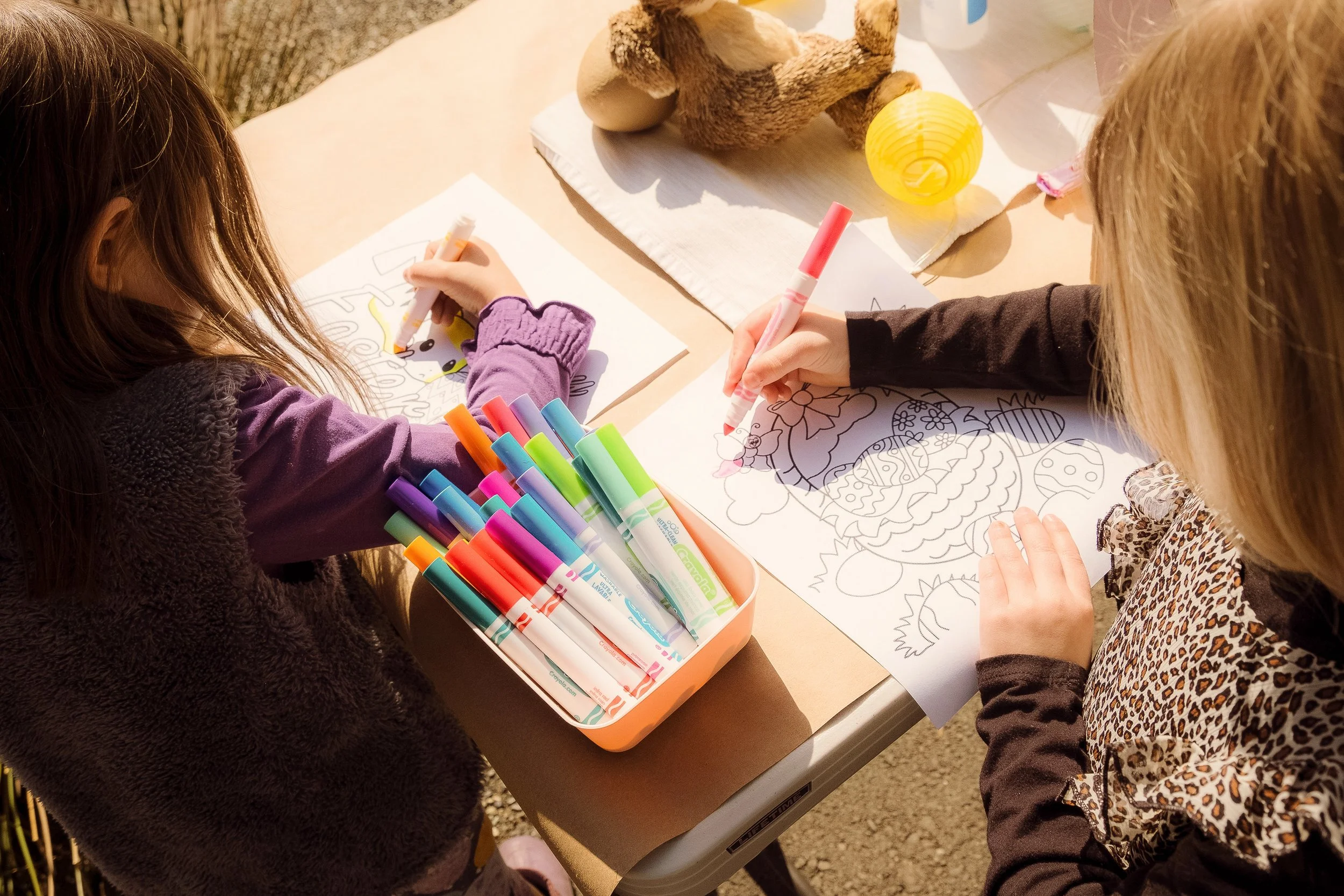When Children Carry the World's Weight: Understanding and Supporting Kids Through Vicarious Trauma
⚠️ Content Notice & Safety Resources
This post discusses vicarious trauma in children, exposure to violence through media, and secondary traumatic stress. If this content feels overwhelming or if you're concerned about a child's safety:
Call or text 988 to reach the 988 Suicide & Crisis Lifeline (available 24/7)
Text "HELLO" to 741741 for the Crisis Text Line
Contact Child Protective Services if a child is in immediate danger
Reach out to Walk Intuit at (213) 286-1031 for trauma-informed individual and family support
It's completely okay to pause reading and seek support. Consider having this conversation with a trusted professional if you're concerned about a child in your care.
Your child comes home unusually quiet after seeing disturbing content online. Your teenager can't sleep, overwhelmed by global crises on their social media feed. Your elementary schooler asks fearful questions about safety after hearing about violence from a friend.
Children today have unprecedented access to global trauma through devices in their pockets. This constant exposure to others' suffering can create genuine trauma symptoms, even when they haven't directly experienced the traumatic event.
This is vicarious trauma in children, and understanding it is essential for every parent today.
Understanding Vicarious Trauma in Children
What is Vicarious Trauma?
Vicarious trauma (also called secondary trauma) occurs when children develop genuine trauma symptoms from exposure to others' traumatic experiences—without directly experiencing the trauma themselves. Research shows children may be traumatized by exposure to the trauma material of others, creating the same neurobiological changes as direct trauma would.
Why Are Children Vulnerable?
Developing brains: Children's brains are still learning to process and contextualize traumatic information
Natural empathy: Their capacity for compassion becomes a vulnerability when they absorb others' suffering without processing tools
Limited coping skills: They lack context to understand events may not directly threaten their safety
Unprecedented access: Today's youth witness more trauma in a day than previous generations saw in years
According to the American Psychological Association, as many as 85% of youth are exposed—directly or indirectly—to violence or other traumatic events.
Recognizing the Signs
Every child responds differently. Watch for changes lasting more than a few weeks:
Younger Children (Ages 3-7)
Regression (bed-wetting, thumb-sucking)
Separation anxiety and clinginess
Sleep disruptions and nightmares
Incorporating traumatic themes into play
Physical complaints (stomachaches, headaches)
Increased tantrums or tearfulness
School-Age Children (Ages 8-12)
Excessive worry about safety
Hypervigilance and startling easily
Concentration problems and declining grades
Social withdrawal
Sleep problems and exhaustion
Behavioral changes or acting out
Persistent questions about death and safety
Teenagers (Ages 13-18)
Emotional numbness or detachment
Survivor's guilt despite not being directly affected
Social isolation
Risk-taking behaviors or substance use
Academic decline
Anger and irritability
Obsessive news consumption
Hopelessness about the future
When to seek help: If symptoms persist beyond a month, intensify, or significantly impair daily functioning, reach out to a mental health professional.
The Somatic Connection: Emotions in the Body
One powerful tool for children experiencing vicarious trauma is learning to recognize emotions in their bodies. The Emotion-Sensation Feeling Wheel helps children connect physical sensations (tight chest, butterflies, hot face) with emotional experiences.
Why this matters: Children often feel things in their bodies before they can name the emotion. This tool:
Gives them language for overwhelming feelings
Validates that their body's responses are real
Creates opportunities for grounding and regulation
Builds emotional intelligence
How to use it:
During calm moments: Explore together when not distressed
In real-time: "Let's check in with your body. What are you noticing?"
After exposure: "That was hard. Should we use the wheel to see what you're feeling?"
Daily check-ins: "How big are your feelings today?"
Six Ways to Support Your Child
1. Create Safety and Connection
Children need to feel safe before anything else. Establish emotional and physical security through:
Physical affection appropriate for their age
Focused attention without distractions
Predictable routines (meals, bedtime, family time)
Your calm presence (they regulate through you)
Clear, consistent boundaries
For teens: While they may resist, your presence matters. "I know you're grown, but I need to give you a hug."
2. Open the Door for Conversation
Don't force it, but make space:
"I've noticed you seem worried. Want to talk?"
"What have you heard about [event] that's bothering you?"
Validate, don't minimize: "If I'm you, those things are incredibly scary"
Avoid fixes: Skip "You'll be fine" and just listen
Use honest language: Real words (hurricane, violence) empower school-age kids
Allow silence: Processing takes time
3. Teach Emotional Regulation
Children learn by watching you manage big feelings.
Practical strategies:
Breathing: In for 4, hold for 4, out for 6
Grounding: Name 5 things you see, 4 you hear, 3 you touch
Movement: Dance, run, shake out the body
Nature time: Green spaces are healing
Creative outlets: Art, music, writing, building
Model it: "I'm anxious about that news. I'm going to take deep breaths and walk. Join me?"
4. Set Media Boundaries
Exposure frequency matters for trauma risk.
Age-appropriate limits:
Under 10: No independent news/social media access
Ages 10-12: Limited, supervised access with time limits
Teens: Collaborative conversations about healthy habits; phones charge outside bedrooms
All ages: Tech-free zones at meals and bedtime
Discuss why you're setting limits and offer alternatives.
5. Focus on Helpers and Hope
Combat helplessness with empowerment:
Point out people helping in crises
Discuss community recovery efforts
Create age-appropriate action opportunities (donations, letters, volunteering)
Tell stories of resilience and recovery
Balance awareness with emphasizing safety
For teens: Give them household responsibilities and praise their contributions.
6. Know When to Seek Professional Help
Seek support if:
Symptoms persist beyond a month or intensify
Your child mentions self-harm or suicide
Daily functioning is significantly impaired
You feel overwhelmed and unsure how to help
Your child has experienced a loss and needs grief support
Options:
Individual therapy tailored to your child's age
Free grief groups (if they've lost a loved one) at Walk Intuit for ages 5-25
Family therapy when everyone needs support
Remember: Recognizing you need help is strength, not weakness.
Parents Need Support Too
Witnessing your child's suffering can be traumatic. You cannot pour from an empty cup, your emotional regulation directly impacts your ability to support your child.
Essential self-care:
Process your own reactions before discussing with children
Seek support from other parents or professionals
Set your own media boundaries
Practice the same regulation strategies you're teaching
Give yourself grace—there's no perfect way
Consider therapy if you're struggling
Remember: You're navigating something unprecedented. Taking care of yourself isn't selfish—it's necessary.
Walk Intuit's Support for Children and Families
We understand children experiencing vicarious trauma need specialized, developmentally appropriate support that honors their empathy while building resilience.
Individual Therapy
Children (Ages 3-11) - In-person in Orange County:
Play therapy and expressive arts
Somatic interventions for body-based regulation
Parent collaboration for home support
Teens & Young Adults (Ages 12+) - In-person or Telehealth:
Trauma-focused therapy (EMDR, TF-CBT, somatic approaches)
Teen-specific support for identity and relationships
Available in-person (OC) or telehealth (statewide CA)
Families:
Family therapy for trauma's impact on the whole system
Parent guidance and sibling support
Specialized approaches: Trauma-Focused CBT, EMDR, play therapy, somatic experiencing, attachment-focused therapy, DBT skills, narrative therapy
Accessibility: Most insurance accepted, sliding scale available, community-funded scholarships
Free Grief Support Groups
Sometimes vicarious trauma intersects with personal loss. We offer no-cost grief groups for youth who've experienced the death of a loved one.
Youth Grief Groups (Ages 5–17): Led by pre-licensed clinicians with expertise in child development and grief-informed care.
Somatic grief processing through movement and art
Storytelling and memory-sharing
Emotional regulation techniques
Peer support and age-specific coping tools
Progress tracking at intake, midpoint, and final session
Young Adult Grief Group (Ages 18–25) - Virtual: Trauma-informed space for processing grief through somatic practices, creative expression, and peer connection.
Supportive virtual peer group
Somatic, creative, and relational processing tools
Space for self-expression and community-building
Learn more: walkintuit.org/grief-groups
Why Walk Intuit:
Trained in childhood trauma and grief
Trauma-informed care principles
Free grief groups for all
Sliding scale and insurance accepted
Healing happens in relationship
Getting Started
Orange County Families:
In-person individual therapy available for all ages at our San Juan Capistrano location
Specializing in children (ages 3-11) and teens (12+)
Free grief groups for youth ages 5-17 (in-person)
California Families (Statewide):
Telehealth individual therapy available for ages 12 and older
Access trauma-informed therapy from anywhere in California
Virtual grief group for young adults ages 18-25 (no cost)
How to Connect:
Phone: (213) 286-1031
Email: info@walkintuit.com
Website: walkintuit.org
Grief Groups: walkintuit.org/grief-groups
Address: 27128 Paseo Espada, San Juan Capistrano, CA 92675
Additional Resources for Families
Crisis Support (Available 24/7)
988 Suicide & Crisis Lifeline: Call or text 988
Crisis Text Line: Text HELLO to 741741
National Child Abuse Hotline: 1-800-4-A-CHILD (1-800-422-4453)
Walk Intuit Scheduling Team: (213) 286-1031
Educational Resources
Walk Intuit Grief Support Groups: walkintuit.org/grief-groups - Free grief groups for youth ages 5-25
National Child Traumatic Stress Network: nctsn.org - Comprehensive resources for families dealing with childhood trauma
Child Mind Institute: childmind.org - Helping children cope with traumatic events
American Academy of Pediatrics: Guidance on media and children
Emotion-Sensation Feeling Wheel: Lindsay Braman's somatic feelings wheel
The Path Forward
Supporting children through vicarious trauma isn't about shielding them from all difficulties, it's about helping them develop emotional tools and resilience to engage with a complex world while maintaining safety, hope, and agency.
Core Truths to Remember:
Connection heals: Relationships are where trauma occurs and where healing happens
Presence over perfection: Children need you present, not perfect
Empathy with boundaries: Honor their caring heart while teaching self-protection
Small steps matter: Every conversation and connection builds resilience
Healing is possible: With support, children develop greater empathy, resilience, and compassion
Give yourself grace. Seek support when needed. Your love and willingness to show up matters profoundly.
If you're concerned about your child—we're here. Walk Intuit's trauma-informed clinicians are ready to support your family.
Because every child deserves to feel safe, connected, and hopeful—even in an overwhelming world.
Walk Intuit is a California-based 501(c)(3) nonprofit organization providing trauma-informed therapy and support services throughout California. We specialize in children's mental health, family therapy, and trauma recovery. Our mission is to walk alongside individuals and families through life's most difficult moments with clinical expertise, intuitive attunement, and deep compassion.
References and Research Citations
Howard, S. (2021). A Causal Model of Children's Vicarious Traumatization. Journal of Child & Adolescent Trauma, 14, 443-454. https://doi.org/10.1007/s40653-020-00331-z
Kanya, M., Reese, R., & Vig, K. (2025). Constantly Connected: What Healthcare Providers Need to Know About Vicarious Trauma in an Evolving Digitally Connected Global Community. Missouri Medicine, 122(1). https://pmc.ncbi.nlm.nih.gov/articles/PMC12331314/
Newport Academy. (2025). Vicarious Trauma in Teens: What It Is & Why It Matters. https://www.newportacademy.com/resources/well-being/vicarious-traumatization/
Charlie Health. (2024). Secondary Trauma and Its Impact on Young People. https://www.charliehealth.com/post/secondary-trauma-and-its-impact-on-young-people
National Institute of Mental Health. Helping Children and Adolescents Cope With Traumatic Events. https://www.nimh.nih.gov/health/publications/helping-children-and-adolescents-cope-with-disasters-and-other-traumatic-events
Child Mind Institute. (2025). How to Help Children Cope With Trauma. https://childmind.org/guide/helping-children-cope-after-a-traumatic-event/
Embark Behavioral Health. (2025). Vicarious Trauma: Recognize and Treat It So Children Can Heal. https://www.embarkbh.com/treatment/trauma-ptsd/vicarious-trauma/
Queen City Counseling. (2025). Impact of Vicarious Trauma on Parenting. https://qc-counseling.com/impact-of-vicarious-trauma-on-parenting/
MARE (Multidimensional Attachment &Relationship Enrichment). (2024). Trauma-Informed Parenting: Your Complete Guide. https://www.mareinc.org/articles/trauma-informed-parenting-overview
National Child Traumatic Stress Network. Families and Caregivers Resources. https://www.nctsn.org/audiences/families-and-caregivers
University of California San Francisco. (2024). Child-Parent Therapy Has Biological Benefits for Traumatized Kids. https://www.ucsf.edu/news/2024/06/427976/treating-trauma-in-young-kids-may-ward-off-adulthood-disease
Braman, L. Emotion-Sensation Feeling Wheel: A Mind-Body-Emotion Therapy Resource. https://shop.lindsaybraman.com/products/emotion-sensation-feeling-wheel-therapy-resource/

